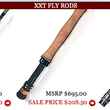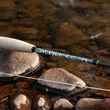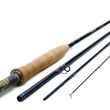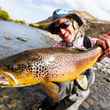Casting demonstrations are a great way to introduce tenkara. For the last couple of years, I have had the good fortune to do tenkara casting demos at The Fly Fishing Shows in Winston-Salem, North Carolina and Lancaster, Pennsylvania and the Virginia Fly Fishing Festival.
Among the myriad benefits of fishing with a tenkara rod is how easy the rod is to cast. While the fundamental casting principles still apply, the simplicity of the outfit; just a rod and a line, make casting a very simple and intuitive process.
A fly rod and reel outfit uses a rod that is designed to cast a weighted line. As my friend Dusty Wissmath likes to say; it is a flexible lever designed to cast a flexible weight. Each rod is designed to cast a specific line weight. There needs to be a certain amount of that weighted line out beyond the rod tip to make the rod cast the line to the target. The weighted line is essential to the system. It is what allows the rod to load and make the cast.
The caster loads the rod using the force of physical energy to build potential energy (bend or "load" the rod) that when released (the rod straightens) becomes kinetic energy transferred to the line, delivering the fly to the target. The weighted line is essential to building the amount of potential energy or load in the rod.
A tenkara rod is a very flexible lever designed to cast a variety of very light lines. The line weight is not the essential element to loading the rod. Just moving your arm or flicking your wrist will load the rod.
Let's look at the steps for casting a conventional fly rod.
- Start with the rod tip on or near the surface of the water with two or three-rod lengths of line out in front of you.
- Raise and accelerate the rod backward to an abrupt stop just past vertical.
- Let the line extend straight out behind you.
- Accelerate the rod forward to an abrupt stop with the rod tip at about head level.
- Follow the line down to the water.
Now let's look at the steps for casting a tenkara rod.
- Start with the rod tip in front of you with about a rod length of line hanging from the tip of the rod.
- Accelerate the rod backward to an abrupt stop just before or at vertical.
- Let the line extend straight out behind you.
- Accelerate the rod forward to an abrupt stop with the rod tip at about head level.
- Don't follow the line down to the water if you are fishing a dry fly or dry dropper.
The elements of timing, so important in the weighted line system, are not as critical with the tenkara cast because your physical energy controls the loading of the rod. The line plays a much smaller role in making the cast work. This is one of the reasons people enjoy using a tenkara rod. The casting execution is very very simple.
In addition to the above, there are other differences in casting a tenkara rod that contribute to making it easier.
- You can use your wrist to make a cast; a big "no no" with conventional fly casting.
- You don't "shoot" line eliminating the need to master the "pat your head while rubbing your stomach" element of conventional fly casting.
- You don't need to mend the line as often or in most cases at all.
- The cast requires less energy and is slower.
- You tend to cast more "open" loops making casting two fly rigs less prone to tangling.
The takeaway
Casting a tenkara rod is not a whole lot different from casting a conventional fly rod. Someone who has mastered casting a conventional rod will understand it in seconds.
Most beginners will quickly get the hang of it and spend more time concentrating on fishing rather than casting, and isn't that the whole point anyway?































Comments
Chris Stewart replied on Permalink
•Don't follow the line down to the water if you are fishing a dry fly or dry dropper.
Should read •Don't follow the line down to the water.
Keeping the rod tip high all the time does two things: 1) Allows the rod to cushion the shock if a fish hits your fly as soon as it hits the water. If you follow the line down with your rod tip there is no "give" in the system and even a modest fish can break off immediately. 2) Keeps more line off the water, which reduces drag and improves your presentation (which is important for wet flies and nymphs as well as dries). That is the major advantage tenkara has over fishing with a shorter rod and heavier line. Why give it up?
Rather than falling into the trap of fully extending your arm and holding the rod horizontal to get every last inch of casting distance, use a longer rod and keep your arm relaxed with your elbow at your side. You'll catch more fish and won't get a sore arm.
Pages